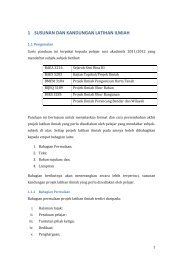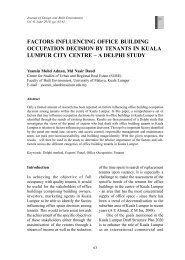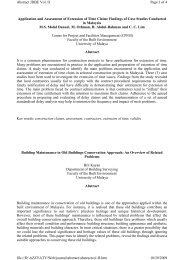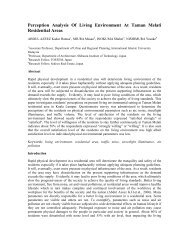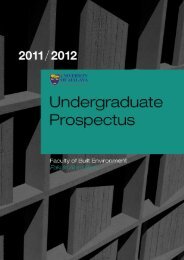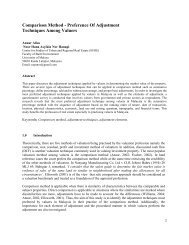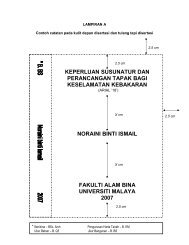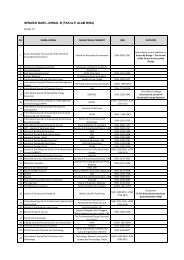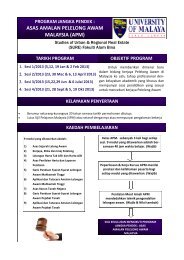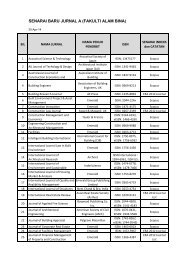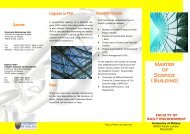Influence of Building Façade Visual Elements on Its Historical Image
Influence of Building Façade Visual Elements on Its Historical Image
Influence of Building Façade Visual Elements on Its Historical Image
You also want an ePaper? Increase the reach of your titles
YUMPU automatically turns print PDFs into web optimized ePapers that Google loves.
Journal <str<strong>on</strong>g>of</str<strong>on</strong>g><br />
Journal <str<strong>on</strong>g>of</str<strong>on</strong>g> Design and Built Envir<strong>on</strong>ment <str<strong>on</strong>g>Influence</str<strong>on</strong>g> <str<strong>on</strong>g>of</str<strong>on</strong>g> <str<strong>on</strong>g>Building</str<strong>on</strong>g> <str<strong>on</strong>g>Façade</str<strong>on</strong>g> <str<strong>on</strong>g>Visual</str<strong>on</strong>g> <str<strong>on</strong>g>Elements</str<strong>on</strong>g> <strong>on</strong> <strong>Its</strong> <strong>Historical</strong> <strong>Image</strong><br />
Design and Built<br />
Envir<strong>on</strong>ment<br />
Volume 5<br />
December 2009<br />
Vol. 5, December 2009, pp. 49–59<br />
<str<strong>on</strong>g>Influence</str<strong>on</strong>g> <str<strong>on</strong>g>of</str<strong>on</strong>g> <str<strong>on</strong>g>Building</str<strong>on</strong>g> <str<strong>on</strong>g>Façade</str<strong>on</strong>g> <str<strong>on</strong>g>Visual</str<strong>on</strong>g> <str<strong>on</strong>g>Elements</str<strong>on</strong>g> <strong>on</strong> <strong>Its</strong><br />
<strong>Historical</strong> <strong>Image</strong>: Case <str<strong>on</strong>g>of</str<strong>on</strong>g> Kuala Lumpur City, Malaysia<br />
Amir Hossein Askari, and Kamariah Binti Dola<br />
Faculty <str<strong>on</strong>g>of</str<strong>on</strong>g> Design and Architecture,<br />
Universiti Putra Malaysia (UPM), Serdang 43400, Selangor, Malaysia<br />
amir.askari@gmail.com / kamariahdola@yahoo.com.sg<br />
Abstract<br />
<str<strong>on</strong>g>Building</str<strong>on</strong>g> façade, as an interface between inner and outer space, is mostly the matter <str<strong>on</strong>g>of</str<strong>on</strong>g> evaluati<strong>on</strong> by<br />
visitors <str<strong>on</strong>g>of</str<strong>on</strong>g> historical districts. Therefore, it imposes important impact <strong>on</strong> the images <str<strong>on</strong>g>of</str<strong>on</strong>g> historical<br />
districts. The dimensi<strong>on</strong> <str<strong>on</strong>g>of</str<strong>on</strong>g> this impact is mostly reliant <strong>on</strong> the visual elements <str<strong>on</strong>g>of</str<strong>on</strong>g> historical building<br />
facades. Reviewing studies c<strong>on</strong>ducted <strong>on</strong> the study area, a historical district adjacent to Dataran<br />
Merdeka in Kuala Lumpur city, revealed that inc<strong>on</strong>sistency am<strong>on</strong>g the elements <str<strong>on</strong>g>of</str<strong>on</strong>g> historical building<br />
facades has negative impact <strong>on</strong> the historical images <str<strong>on</strong>g>of</str<strong>on</strong>g> the area. Therefore, the study intended to<br />
identify the visual elements that influence the images <str<strong>on</strong>g>of</str<strong>on</strong>g> historical building facades, based <strong>on</strong> public’s<br />
evaluati<strong>on</strong>s. Using a quantitative method, the data was collected through a self-administered<br />
questi<strong>on</strong>naire survey. Participants were randomly selected from the public who visited the area. The<br />
results showed that architectural style and color were the visual elements that mostly influenced the<br />
images <str<strong>on</strong>g>of</str<strong>on</strong>g> historical building facades. Briefly, the results help to find out how people evaluate the<br />
images <str<strong>on</strong>g>of</str<strong>on</strong>g> historical building facades that assists designers and pr<str<strong>on</strong>g>of</str<strong>on</strong>g>essi<strong>on</strong>als in their efforts for the<br />
future development <str<strong>on</strong>g>of</str<strong>on</strong>g> historical building facades.<br />
Keywords: <strong>Historical</strong> building façades; <str<strong>on</strong>g>Visual</str<strong>on</strong>g> elements; Architectural style<br />
Introducti<strong>on</strong><br />
<strong>Historical</strong> building facades are preferred<br />
more over new <strong>on</strong>es (Herzog et al., 1982;<br />
Marina and Renato, 2006). Therefore,<br />
historical building facades are important<br />
as they impose impact <strong>on</strong> the images <str<strong>on</strong>g>of</str<strong>on</strong>g><br />
districts. Public’s mental presentati<strong>on</strong> <str<strong>on</strong>g>of</str<strong>on</strong>g><br />
buildings is mostly based <strong>on</strong> facades<br />
(Imamoglu, 2000). Similarly, the<br />
appearance <str<strong>on</strong>g>of</str<strong>on</strong>g> building is mostly the issue<br />
<str<strong>on</strong>g>of</str<strong>on</strong>g> evaluati<strong>on</strong> and influences the façade<br />
image and architectural quality (Robbins<br />
49<br />
and Langt<strong>on</strong>, 1999; Gifford et al., 2000;<br />
Brown and Gifford, 2001). Different<br />
studies such as Mehrabian and Russell<br />
(1974); Russell et al. (1981), and Gifford<br />
et al. (2000) have elaborated how<br />
observers’ resp<strong>on</strong>ses to their architectural<br />
evaluati<strong>on</strong>s are related to their evaluati<strong>on</strong>s<br />
for different building facades. People<br />
mostly evaluate the images <str<strong>on</strong>g>of</str<strong>on</strong>g> historical<br />
building façades based <strong>on</strong> visual elements<br />
such as shapes, colors, and architectural<br />
styles. This implies that the visual<br />
elements <str<strong>on</strong>g>of</str<strong>on</strong>g> historical building facades<br />
Editors<br />
Ezrin Arbi<br />
S.P. Rao
Amir Hossein Askari, and Kamariah Binti Dola<br />
influence the images <str<strong>on</strong>g>of</str<strong>on</strong>g> districts.<br />
Therefore, the study intends to identify<br />
the visual elements <str<strong>on</strong>g>of</str<strong>on</strong>g> historical building<br />
facades that mostly influence the images<br />
<str<strong>on</strong>g>of</str<strong>on</strong>g> study area. To do so, the study aims to<br />
find out how people evaluate the<br />
importance <str<strong>on</strong>g>of</str<strong>on</strong>g> historical building facades<br />
visual elements <strong>on</strong> the image <str<strong>on</strong>g>of</str<strong>on</strong>g> the study<br />
area. The literature review secti<strong>on</strong><br />
discusses the visual elements <str<strong>on</strong>g>of</str<strong>on</strong>g> building<br />
facades, and theories <strong>on</strong> how people<br />
evaluate the images <str<strong>on</strong>g>of</str<strong>on</strong>g> building facades.<br />
<str<strong>on</strong>g>Building</str<strong>on</strong>g> <str<strong>on</strong>g>Façade</str<strong>on</strong>g> and City <strong>Image</strong><br />
<str<strong>on</strong>g>Façade</str<strong>on</strong>g> is the face <str<strong>on</strong>g>of</str<strong>on</strong>g> the building that<br />
shows its value and structure (Huxtable,<br />
2004). It is the c<strong>on</strong>necti<strong>on</strong> between inner<br />
and outer space (Hayashi, 2004) that<br />
imposes c<strong>on</strong>siderable impact <strong>on</strong> the city<br />
image (Moughtin et al., 1995; Abu-<br />
Ghazzeh, 1997; K<strong>on</strong>g and Yeoh, 2004;<br />
Hui, 2007). Huxtable (2004) menti<strong>on</strong>ed<br />
that even the scale around a building is<br />
specified with its facades. Urban space<br />
is characterized by building façade,<br />
neighboring building facades,<br />
streetscape, and envir<strong>on</strong>ment (Huxtable,<br />
2004). Thereby, building facade<br />
influences all aspects <str<strong>on</strong>g>of</str<strong>on</strong>g> its ambience and<br />
illustrates its significance in relati<strong>on</strong> to<br />
the images <str<strong>on</strong>g>of</str<strong>on</strong>g> city and subsequently<br />
historical districts. A building façade<br />
presents various experiences to the<br />
viewers (Moughtin et al., 1995) and is<br />
mostly c<strong>on</strong>sidered for the evaluati<strong>on</strong> <str<strong>on</strong>g>of</str<strong>on</strong>g> a<br />
historical district image. In fact, the image<br />
<str<strong>on</strong>g>of</str<strong>on</strong>g> a historical building façade is<br />
presentable through its visual elements<br />
that are basic elements <str<strong>on</strong>g>of</str<strong>on</strong>g> visitors’<br />
evaluati<strong>on</strong>s. Next secti<strong>on</strong> stresses the<br />
50<br />
importance <str<strong>on</strong>g>of</str<strong>on</strong>g> these visual elements so<br />
as to shape the images <str<strong>on</strong>g>of</str<strong>on</strong>g> historical<br />
building façades.<br />
The <strong>Image</strong> <str<strong>on</strong>g>of</str<strong>on</strong>g> a <strong>Historical</strong> <str<strong>on</strong>g>Building</str<strong>on</strong>g><br />
Facade<br />
The images <str<strong>on</strong>g>of</str<strong>on</strong>g> historical building facades<br />
are mostly represented through their<br />
visual elements. Architectural style<br />
(Nasar, 1989; Stamps III, 1991; Karaman,<br />
2005; Hui, 2007), color, volume,<br />
perceived value, material (Karaman,<br />
2005; Hui, 2007), visual bulky shapes and<br />
elements (Stamps III and Nasar, 1997;<br />
Gifford et al., 2000), forms, surfaces, and<br />
lights (Swirn<str<strong>on</strong>g>of</str<strong>on</strong>g>f, 1982) are important<br />
elements that shape the images <str<strong>on</strong>g>of</str<strong>on</strong>g><br />
historical building facades. Curved lines<br />
and decorated articulati<strong>on</strong> (Frewald,<br />
1990), cleanliness and ornament (Nasar,<br />
1983; Stamps III, 1999; Akalin et al.,<br />
2009), and detail and texture (Stamps III,<br />
1999; Akalin et al., 2009) could also<br />
shape the images <str<strong>on</strong>g>of</str<strong>on</strong>g> historical building<br />
facades in districts (Gifford et al., 2000).<br />
From different point <str<strong>on</strong>g>of</str<strong>on</strong>g> view, the age <str<strong>on</strong>g>of</str<strong>on</strong>g><br />
building façade is also influential <strong>on</strong> its<br />
historical image (Stamps III and Nasar,<br />
1997; Gifford et al., 2000). Herzog et al.<br />
(1982) and Marina and Renato (2006)<br />
also menti<strong>on</strong>ed that older buildings are<br />
more preferred than c<strong>on</strong>temporary <strong>on</strong>es.<br />
In fact, the age <str<strong>on</strong>g>of</str<strong>on</strong>g> a building façade affects<br />
its historical image and root, and<br />
augments its visual richness and quality.<br />
After identifying the visual elements <str<strong>on</strong>g>of</str<strong>on</strong>g><br />
historical building facades, the next<br />
secti<strong>on</strong> opens discussi<strong>on</strong> <strong>on</strong> theories<br />
about visitors’ evaluati<strong>on</strong> <str<strong>on</strong>g>of</str<strong>on</strong>g> historical<br />
building facades.
Evaluati<strong>on</strong> <str<strong>on</strong>g>of</str<strong>on</strong>g> a <strong>Historical</strong> <str<strong>on</strong>g>Building</str<strong>on</strong>g><br />
<str<strong>on</strong>g>Façade</str<strong>on</strong>g><br />
The significance <str<strong>on</strong>g>of</str<strong>on</strong>g> building façade<br />
evaluati<strong>on</strong> is stressed by numerous<br />
studies such as Robbins and Langt<strong>on</strong><br />
(1999); Imamoglu (2000); Gifford et al.<br />
(2000), and Brown and Gifford (2001).<br />
This significance is critical, whereas they<br />
state that evaluati<strong>on</strong> <str<strong>on</strong>g>of</str<strong>on</strong>g> the builtenvir<strong>on</strong>ment<br />
architectural quality is<br />
partially achieved based <strong>on</strong> building<br />
physical features. Some studies such as<br />
Mehrabian and Russell (1974); Baloglu<br />
and McCleary (1999); Gifford et al.<br />
(2000), and Beerli and Martý´n (2004)<br />
stated that not <strong>on</strong>ly physical features, but<br />
also some pers<strong>on</strong>al factors such as<br />
observers’ emoti<strong>on</strong>al resp<strong>on</strong>ses to the<br />
building affect the evaluati<strong>on</strong> <str<strong>on</strong>g>of</str<strong>on</strong>g> builtenvir<strong>on</strong>ment<br />
architectural quality. In a<br />
study, Coeterier (2002) stressed that<br />
public’s evaluati<strong>on</strong>s <str<strong>on</strong>g>of</str<strong>on</strong>g> historical building<br />
facades are based <strong>on</strong> form, informati<strong>on</strong><br />
about identity and background <str<strong>on</strong>g>of</str<strong>on</strong>g> the<br />
building, or knowledge, use or functi<strong>on</strong>,<br />
and familiarity. The criteria for the<br />
attractiveness <str<strong>on</strong>g>of</str<strong>on</strong>g> a historical building<br />
façade are introduced as color, material,<br />
and proporti<strong>on</strong> (Coeterier, 2002). Brown<br />
and Gifford (2001) stated six cognitive<br />
factors <str<strong>on</strong>g>of</str<strong>on</strong>g> clarity, complexity, friendliness,<br />
originality, ruggedness, and<br />
meaningfulness as the predictors <str<strong>on</strong>g>of</str<strong>on</strong>g> a<br />
building façade evaluati<strong>on</strong>. Groat (1994)<br />
and Gifford et al. (2000) declaring<br />
different view <strong>on</strong> evaluati<strong>on</strong>, menti<strong>on</strong>ed<br />
that evaluati<strong>on</strong> <str<strong>on</strong>g>of</str<strong>on</strong>g> visual quality depends<br />
<strong>on</strong> the degree to which building facades<br />
appear c<strong>on</strong>sistent with their c<strong>on</strong>texts.<br />
Exemplary building facades <str<strong>on</strong>g>of</str<strong>on</strong>g> prototypes<br />
are more matter <str<strong>on</strong>g>of</str<strong>on</strong>g> evaluati<strong>on</strong>s (Purcell<br />
and Nasar, 1992; Gifford et al., 2000).<br />
<str<strong>on</strong>g>Influence</str<strong>on</strong>g> <str<strong>on</strong>g>of</str<strong>on</strong>g> <str<strong>on</strong>g>Building</str<strong>on</strong>g> <str<strong>on</strong>g>Façade</str<strong>on</strong>g> <str<strong>on</strong>g>Visual</str<strong>on</strong>g> <str<strong>on</strong>g>Elements</str<strong>on</strong>g> <strong>on</strong> <strong>Its</strong> <strong>Historical</strong> <strong>Image</strong><br />
51<br />
Some studies believe that emoti<strong>on</strong> toward<br />
building affects visitors’ evaluati<strong>on</strong>s <str<strong>on</strong>g>of</str<strong>on</strong>g><br />
facades. Mehrabian and Russel (1974);<br />
Mehrabian (1976); Gifford et al. (2000),<br />
and Aspinall (2001) stressed that<br />
evaluati<strong>on</strong> is elicited in terms <str<strong>on</strong>g>of</str<strong>on</strong>g> pleasure<br />
and arousal that building facades inspire.<br />
Somewhat similarly, Cubukcu and<br />
Kahraman (2008) completed this issue,<br />
whereas they stated that evaluati<strong>on</strong> <str<strong>on</strong>g>of</str<strong>on</strong>g><br />
building facades is feasible through<br />
measuring preference (like-dislike),<br />
arousal (arousing-sleepy), naturalness<br />
(natural-artificial), and relaxati<strong>on</strong><br />
(relaxing-distressing). As a result, this<br />
study am<strong>on</strong>g all existing theories <strong>on</strong><br />
evaluati<strong>on</strong>s <str<strong>on</strong>g>of</str<strong>on</strong>g> building facades, has<br />
stressed the influence <str<strong>on</strong>g>of</str<strong>on</strong>g> building facades<br />
visual elements that <str<strong>on</strong>g>of</str<strong>on</strong>g>fers the best answer<br />
to the objective <str<strong>on</strong>g>of</str<strong>on</strong>g> the study.<br />
The Study Area<br />
The study area (Fig1) is located near<br />
Dataran Merdeka, in Kuala Lumpur city,<br />
where Malaysians annually celebrate<br />
their independence day. It is a historical<br />
district, in the old city center, which<br />
stands in the Sec<strong>on</strong>d Heritage Z<strong>on</strong>e <str<strong>on</strong>g>of</str<strong>on</strong>g><br />
Kuala Lumpur city. The majority <str<strong>on</strong>g>of</str<strong>on</strong>g> the<br />
buildings include shop-houses appeared<br />
in different architectural styles such as Art<br />
Deco, Neo Classical, Early Col<strong>on</strong>ial,<br />
Utilitarian, and Eclectic. Figure 2 shows<br />
an illustrative introducti<strong>on</strong> <str<strong>on</strong>g>of</str<strong>on</strong>g> the building<br />
facades in the study area.<br />
Methodology<br />
The study was c<strong>on</strong>ducted based <strong>on</strong> a<br />
quantitative method, meanwhile; the data
Amir Hossein Askari, and Kamariah Binti Dola<br />
was collected through a questi<strong>on</strong>naire<br />
survey. The durati<strong>on</strong> <str<strong>on</strong>g>of</str<strong>on</strong>g> data collecti<strong>on</strong><br />
was from December 2008 until January<br />
2009. Pilot study was used to check the<br />
time, efficiency, and wordings <str<strong>on</strong>g>of</str<strong>on</strong>g> the real<br />
questi<strong>on</strong>naire. Meaning that, during pilot<br />
study, some questi<strong>on</strong>s that were difficultto-understand<br />
for participants were<br />
replaced with easy-to-understand <strong>on</strong>es.<br />
The participants were requested to<br />
Fig1. The study area<br />
(Source: City Hall Kuala Lumpur, 2008)<br />
Fig2. <str<strong>on</strong>g>Building</str<strong>on</strong>g> façades in the study area<br />
52<br />
evaluate the importance <str<strong>on</strong>g>of</str<strong>on</strong>g> facades visual<br />
elements by asking them how important<br />
the building fr<strong>on</strong>tage elements are to<br />
influence the historical image <str<strong>on</strong>g>of</str<strong>on</strong>g> the study<br />
area. They ranked their evaluati<strong>on</strong>s based<br />
<strong>on</strong> Likert scale, in the format <str<strong>on</strong>g>of</str<strong>on</strong>g> fivescaled<br />
questi<strong>on</strong>s. The five scales used<br />
included unimportant, somewhat<br />
unimportant, moderately important,<br />
important, and very important.
Participants<br />
Using the method advocated by Mitra and<br />
Lankford (1999), with a c<strong>on</strong>centrati<strong>on</strong> <strong>on</strong><br />
sampling error <str<strong>on</strong>g>of</str<strong>on</strong>g> 0.034, 220 participants<br />
were calculated for the study. They were<br />
the Malaysians, who worked, lived in, or<br />
visited the area. In fact, they were<br />
recognized to be more familiar with the<br />
area and more willing to answer the<br />
questi<strong>on</strong>s. Most <str<strong>on</strong>g>of</str<strong>on</strong>g> participants aged<br />
between 20-30 years old (n=94, 42.8%)<br />
with equal distributi<strong>on</strong> <str<strong>on</strong>g>of</str<strong>on</strong>g> males and<br />
females. The participants below 20 years<br />
old were excluded for they were<br />
c<strong>on</strong>sidered less willing to answer the<br />
questi<strong>on</strong>s. In the discourse <str<strong>on</strong>g>of</str<strong>on</strong>g> participant<br />
educati<strong>on</strong>al level, most participants had<br />
SMP (n=82, 37.3%), and the least<br />
percentage bel<strong>on</strong>ged to the participants<br />
with bachelor degree and above (n=58,<br />
26.3%).<br />
Data Analysis<br />
Data analysis was carried out by means<br />
<str<strong>on</strong>g>of</str<strong>on</strong>g> SPSS (Special Packages for Social<br />
Sciences) s<str<strong>on</strong>g>of</str<strong>on</strong>g>t-ware. Based <strong>on</strong> Pears<strong>on</strong><br />
correlati<strong>on</strong> analysis, the influence <str<strong>on</strong>g>of</str<strong>on</strong>g><br />
<str<strong>on</strong>g>Influence</str<strong>on</strong>g> <str<strong>on</strong>g>of</str<strong>on</strong>g> <str<strong>on</strong>g>Building</str<strong>on</strong>g> <str<strong>on</strong>g>Façade</str<strong>on</strong>g> <str<strong>on</strong>g>Visual</str<strong>on</strong>g> <str<strong>on</strong>g>Elements</str<strong>on</strong>g> <strong>on</strong> <strong>Its</strong> <strong>Historical</strong> <strong>Image</strong><br />
53<br />
visual elements <str<strong>on</strong>g>of</str<strong>on</strong>g> historical facades <strong>on</strong><br />
the visitors’ evaluati<strong>on</strong>s was identified.<br />
The visual elements that influenced the<br />
images <str<strong>on</strong>g>of</str<strong>on</strong>g> historical building facades<br />
were elicited. In other words, the results<br />
elicited the façade elements had the<br />
highest influence <strong>on</strong> the visual richness<br />
<str<strong>on</strong>g>of</str<strong>on</strong>g> historical building facades images.<br />
Results<br />
<str<strong>on</strong>g>Visual</str<strong>on</strong>g> elements impose high impact <strong>on</strong><br />
the images <str<strong>on</strong>g>of</str<strong>on</strong>g> historical building facades.<br />
In this study, the importance <str<strong>on</strong>g>of</str<strong>on</strong>g> these<br />
visual elements was identified through the<br />
c<strong>on</strong>siderati<strong>on</strong> <str<strong>on</strong>g>of</str<strong>on</strong>g> mean scores. After<br />
ranking the importance <str<strong>on</strong>g>of</str<strong>on</strong>g> visual<br />
elements, the relati<strong>on</strong>ship between these<br />
elements and historical building facades<br />
with str<strong>on</strong>g and poor images was pursued<br />
to ascertain the influence <str<strong>on</strong>g>of</str<strong>on</strong>g> these<br />
elements <strong>on</strong> the images <str<strong>on</strong>g>of</str<strong>on</strong>g> historical<br />
building facades. Table 1 shows the<br />
importance <str<strong>on</strong>g>of</str<strong>on</strong>g> historical building facades<br />
visual elements in representing the<br />
historical images.<br />
The results showed that all visual<br />
elements obtained mean scores between<br />
3.8 and 4.4. This implicates that their<br />
Table1. Importance <str<strong>on</strong>g>of</str<strong>on</strong>g> <strong>Historical</strong> <str<strong>on</strong>g>Building</str<strong>on</strong>g> Facades <str<strong>on</strong>g>Visual</str<strong>on</strong>g> <str<strong>on</strong>g>Elements</str<strong>on</strong>g><br />
<str<strong>on</strong>g>Visual</str<strong>on</strong>g> <str<strong>on</strong>g>Elements</str<strong>on</strong>g> Participants<br />
N Mean S.D<br />
Architectural style <str<strong>on</strong>g>of</str<strong>on</strong>g> building fr<strong>on</strong>tage 220 4.4 0.7<br />
Shape <str<strong>on</strong>g>of</str<strong>on</strong>g> building fr<strong>on</strong>tage 220 4.3 0.7<br />
Decorati<strong>on</strong> <str<strong>on</strong>g>of</str<strong>on</strong>g> building fr<strong>on</strong>tage 220 4.2 0.8<br />
Material <str<strong>on</strong>g>of</str<strong>on</strong>g> building fr<strong>on</strong>tage<br />
(brick, c<strong>on</strong>crete, marble)<br />
220 4.1 0.9<br />
Color <str<strong>on</strong>g>of</str<strong>on</strong>g> building fr<strong>on</strong>tage 220 4.0 0.9<br />
Texture <str<strong>on</strong>g>of</str<strong>on</strong>g> building fr<strong>on</strong>tage 220 3.9 0.9<br />
Dimensi<strong>on</strong> <str<strong>on</strong>g>of</str<strong>on</strong>g> building fr<strong>on</strong>tage such as<br />
height, and width<br />
220 3.8 1.0<br />
S.D. Stands for standard deviati<strong>on</strong>.
Amir Hossein Askari, and Kamariah Binti Dola<br />
importance in representing the historical<br />
images ranges from moderately important<br />
to very important. Based <strong>on</strong> this,<br />
architectural style <str<strong>on</strong>g>of</str<strong>on</strong>g> building fr<strong>on</strong>tage<br />
(mean=4.4), shape <str<strong>on</strong>g>of</str<strong>on</strong>g> building fr<strong>on</strong>tage<br />
(mean=4.3), decorati<strong>on</strong> <str<strong>on</strong>g>of</str<strong>on</strong>g> building<br />
fr<strong>on</strong>tage (mean=4.2), and material <str<strong>on</strong>g>of</str<strong>on</strong>g><br />
building fr<strong>on</strong>tage (mean=4.1) are the<br />
most important factors in representing the<br />
images <str<strong>on</strong>g>of</str<strong>on</strong>g> historical building facades. In<br />
c<strong>on</strong>trast, dimensi<strong>on</strong> <str<strong>on</strong>g>of</str<strong>on</strong>g> building fr<strong>on</strong>tage<br />
(mean=3.8) and texture <str<strong>on</strong>g>of</str<strong>on</strong>g> building<br />
fr<strong>on</strong>tage (mean=3.9) are the visual<br />
elements <str<strong>on</strong>g>of</str<strong>on</strong>g> less importance.<br />
Nevertheless, they should not be<br />
understated for the future development<br />
<str<strong>on</strong>g>of</str<strong>on</strong>g> historical building facades. In this<br />
between, color as an important element<br />
<str<strong>on</strong>g>of</str<strong>on</strong>g> historical building facades obtained<br />
mean score (4), which this implies its<br />
influence <strong>on</strong> the historical images. The<br />
Fig3. The historical building facades with str<strong>on</strong>g images<br />
54<br />
applicati<strong>on</strong> <str<strong>on</strong>g>of</str<strong>on</strong>g> colors <strong>on</strong> the historical<br />
building façades should not tarnish the<br />
harm<strong>on</strong>y <str<strong>on</strong>g>of</str<strong>on</strong>g> streetscape. Colors such as<br />
grey and white (shown in Fig3.) are<br />
c<strong>on</strong>sidered to be the most appropriate for<br />
the historical building facades. In the next<br />
secti<strong>on</strong>s, the relati<strong>on</strong>ship between these<br />
visual elements and historical building<br />
facades with str<strong>on</strong>g and poor images is<br />
identified. Figure 3 and 4 respectively<br />
illustrate historical building facades with<br />
str<strong>on</strong>g and poor images.<br />
<str<strong>on</strong>g>Influence</str<strong>on</strong>g> <str<strong>on</strong>g>of</str<strong>on</strong>g> <str<strong>on</strong>g>Visual</str<strong>on</strong>g> <str<strong>on</strong>g>Elements</str<strong>on</strong>g> <strong>on</strong> the<br />
<strong>Image</strong>s <str<strong>on</strong>g>of</str<strong>on</strong>g> <strong>Historical</strong> <str<strong>on</strong>g>Building</str<strong>on</strong>g><br />
Facades<br />
<str<strong>on</strong>g>Visual</str<strong>on</strong>g> elements were stipulated to affect<br />
people’s evaluati<strong>on</strong>s <str<strong>on</strong>g>of</str<strong>on</strong>g> historical building<br />
facades. To understand the dimensi<strong>on</strong> <str<strong>on</strong>g>of</str<strong>on</strong>g>
Fig4. The historical building facades with poor images<br />
this influence, the Pears<strong>on</strong> correlati<strong>on</strong><br />
analysis was used to find the relati<strong>on</strong>ship<br />
between visual elements and evaluati<strong>on</strong><br />
<str<strong>on</strong>g>of</str<strong>on</strong>g> historical facades with str<strong>on</strong>g and poor<br />
images (table 2. and 3.).<br />
The results <str<strong>on</strong>g>of</str<strong>on</strong>g> Pears<strong>on</strong> correlati<strong>on</strong><br />
analysis elaborated that some visual<br />
elements influence the evaluati<strong>on</strong>s <str<strong>on</strong>g>of</str<strong>on</strong>g><br />
historical building facades with str<strong>on</strong>g<br />
images. Am<strong>on</strong>g all elements, architectural<br />
style (r=0.231**, p
Amir Hossein Askari, and Kamariah Binti Dola<br />
Table2. Correlati<strong>on</strong> between <str<strong>on</strong>g>Visual</str<strong>on</strong>g> <str<strong>on</strong>g>Elements</str<strong>on</strong>g> and <strong>Historical</strong> <str<strong>on</strong>g>Building</str<strong>on</strong>g> Facades with<br />
Str<strong>on</strong>g <strong>Image</strong>s<br />
Scene (n) Architectural style <str<strong>on</strong>g>of</str<strong>on</strong>g> Shape <str<strong>on</strong>g>of</str<strong>on</strong>g> Material <str<strong>on</strong>g>of</str<strong>on</strong>g><br />
(Shown in Fig3.) building fr<strong>on</strong>tage building fr<strong>on</strong>tage building fr<strong>on</strong>tage<br />
28 0.231**<br />
0.001<br />
37 0.223**<br />
0.001<br />
30 0.185**<br />
0.006<br />
24 0.189** 0.149* 0.176**<br />
0.005 0.027 0.009<br />
27 0.229**<br />
0.001<br />
**. Correlati<strong>on</strong> is significant at the 0.01 level (2-tailed).<br />
*. Correlati<strong>on</strong> is significant at the 0.05 level (2-tailed).<br />
Table3. Correlati<strong>on</strong> between <str<strong>on</strong>g>Visual</str<strong>on</strong>g> <str<strong>on</strong>g>Elements</str<strong>on</strong>g> and <strong>Historical</strong> <str<strong>on</strong>g>Building</str<strong>on</strong>g> Facades with<br />
Poor <strong>Image</strong>s<br />
Scene (n) Color <str<strong>on</strong>g>of</str<strong>on</strong>g> building fr<strong>on</strong>tage<br />
(Shown in Fig4.)<br />
4 -0.149*<br />
0.027<br />
5 -0.191**<br />
0.004<br />
10 -0.150*<br />
0.026<br />
**. Correlati<strong>on</strong> is significant at the 0.01 level (2-tailed).<br />
*. Correlati<strong>on</strong> is significant at the 0.05 level (2-tailed).<br />
to weaken the images <str<strong>on</strong>g>of</str<strong>on</strong>g> historical<br />
building façades (as shown in Fig4.). The<br />
results are parallel with the findings <str<strong>on</strong>g>of</str<strong>on</strong>g><br />
Swirn<str<strong>on</strong>g>of</str<strong>on</strong>g>f (1982); Karaman (2005), and<br />
Hui (2007) that introduced color as an<br />
influential element <strong>on</strong> the evaluati<strong>on</strong> <str<strong>on</strong>g>of</str<strong>on</strong>g><br />
a building facade image.<br />
C<strong>on</strong>clusi<strong>on</strong><br />
<strong>Historical</strong> building façades impose<br />
impact <strong>on</strong> the historical images in the<br />
56<br />
districts. For the sake <str<strong>on</strong>g>of</str<strong>on</strong>g> brevity, visitors’<br />
evaluati<strong>on</strong>s <str<strong>on</strong>g>of</str<strong>on</strong>g> historical districts are<br />
mostly c<strong>on</strong>centrated <strong>on</strong> the historical<br />
building facades. In other words, the<br />
architectural and historical quality <str<strong>on</strong>g>of</str<strong>on</strong>g> a<br />
historical district is mostly evaluated by<br />
the images <str<strong>on</strong>g>of</str<strong>on</strong>g> its historical building<br />
facades. Evaluati<strong>on</strong>s <str<strong>on</strong>g>of</str<strong>on</strong>g> historical<br />
building facades are elicited through both<br />
visual elements and the emoti<strong>on</strong> that is<br />
aroused toward facades. Hence, the study<br />
focused <strong>on</strong> the evaluati<strong>on</strong>s <str<strong>on</strong>g>of</str<strong>on</strong>g> historical<br />
building facades based <strong>on</strong> the visual
elements such as shape, color, material,<br />
and so <strong>on</strong>. The results showed that<br />
architectural style, shape, decorati<strong>on</strong>, and<br />
material were respectively the most<br />
important visual elements in presenting<br />
the images <str<strong>on</strong>g>of</str<strong>on</strong>g> historical building facades.<br />
Color and texture were less important<br />
visual elements in shaping the images <str<strong>on</strong>g>of</str<strong>on</strong>g><br />
historical building facades. Nevertheless,<br />
their influence should not be understated<br />
in the future c<strong>on</strong>servati<strong>on</strong> or<br />
development. In the further step, results<br />
showed that architectural style, material,<br />
and shape positively influenced the visual<br />
richness <str<strong>on</strong>g>of</str<strong>on</strong>g> historical building facades<br />
images. In fact, these visual elements<br />
were c<strong>on</strong>tributive to enhancing the<br />
historical images in the districts, which<br />
am<strong>on</strong>g all; architectural style was<br />
c<strong>on</strong>sidered as the most influential<br />
element. On the other hand, color was the<br />
<strong>on</strong>ly visual element that negatively<br />
influenced the images <str<strong>on</strong>g>of</str<strong>on</strong>g> historical<br />
building facades. The use <str<strong>on</strong>g>of</str<strong>on</strong>g> inc<strong>on</strong>sistent<br />
colors such as pink, yellow, and blue<br />
tarnishes the historical images <str<strong>on</strong>g>of</str<strong>on</strong>g> building<br />
facades in the districts within the city.<br />
Colors such as grey and white are the<br />
most suitable for historical building<br />
facades and enhance the quality and<br />
visual richness <str<strong>on</strong>g>of</str<strong>on</strong>g> streetscape. As<br />
menti<strong>on</strong>ed before, most <str<strong>on</strong>g>of</str<strong>on</strong>g> visitors agreed<br />
with the importance <str<strong>on</strong>g>of</str<strong>on</strong>g> architectural styles<br />
in influencing and shaping the images <str<strong>on</strong>g>of</str<strong>on</strong>g><br />
historical building facades. This implies<br />
that visitors regardless <str<strong>on</strong>g>of</str<strong>on</strong>g> possessing<br />
architectural background are aware <str<strong>on</strong>g>of</str<strong>on</strong>g><br />
importance <str<strong>on</strong>g>of</str<strong>on</strong>g> architectural issues in<br />
historical districts. Since, public’s<br />
evaluati<strong>on</strong>s <str<strong>on</strong>g>of</str<strong>on</strong>g> historical building facades<br />
are different from that <str<strong>on</strong>g>of</str<strong>on</strong>g> pr<str<strong>on</strong>g>of</str<strong>on</strong>g>essi<strong>on</strong>al, a<br />
future study is recommended to compare<br />
the evaluati<strong>on</strong> <str<strong>on</strong>g>of</str<strong>on</strong>g> these two groups. The<br />
<str<strong>on</strong>g>Influence</str<strong>on</strong>g> <str<strong>on</strong>g>of</str<strong>on</strong>g> <str<strong>on</strong>g>Building</str<strong>on</strong>g> <str<strong>on</strong>g>Façade</str<strong>on</strong>g> <str<strong>on</strong>g>Visual</str<strong>on</strong>g> <str<strong>on</strong>g>Elements</str<strong>on</strong>g> <strong>on</strong> <strong>Its</strong> <strong>Historical</strong> <strong>Image</strong><br />
57<br />
limitati<strong>on</strong> <str<strong>on</strong>g>of</str<strong>on</strong>g> the results did not allow the<br />
researcher to find out how culture and<br />
ethnicity influence the evaluati<strong>on</strong>s, which<br />
is left for future studies. Totally, the<br />
results <str<strong>on</strong>g>of</str<strong>on</strong>g> this study bridged architecture<br />
and people’s envir<strong>on</strong>mental evaluati<strong>on</strong>s<br />
<str<strong>on</strong>g>of</str<strong>on</strong>g> historical building facades as an<br />
important issue in today urban design. In<br />
fact, the accuracy in the use <str<strong>on</strong>g>of</str<strong>on</strong>g> results<br />
derived from people’s evaluati<strong>on</strong>s assists<br />
designers in their attempts for the future<br />
tropical development <str<strong>on</strong>g>of</str<strong>on</strong>g> historical<br />
building facades. Therefore, the<br />
c<strong>on</strong>tributi<strong>on</strong> is the effort for improving<br />
the envir<strong>on</strong>mental sustainability <str<strong>on</strong>g>of</str<strong>on</strong>g> the<br />
area. The future c<strong>on</strong>servati<strong>on</strong> <str<strong>on</strong>g>of</str<strong>on</strong>g> historical<br />
sites should not be the domain <str<strong>on</strong>g>of</str<strong>on</strong>g><br />
pr<str<strong>on</strong>g>of</str<strong>on</strong>g>essi<strong>on</strong>als <strong>on</strong>ly, as public should be<br />
allowed to participate in the planning and<br />
designing <str<strong>on</strong>g>of</str<strong>on</strong>g> historical areas.<br />
Acknowledgement<br />
This study was partly funded by<br />
Universiti Putra Malaysia. The authors<br />
would like to express their gratitude to<br />
the Faculty <str<strong>on</strong>g>of</str<strong>on</strong>g> Design and Architecture,<br />
Universiti Putra Malaysia. Special thanks<br />
should be given to Pr<str<strong>on</strong>g>of</str<strong>on</strong>g>. Dr. Dato’ Ar.<br />
Elias @ Ilias Bin Salleh and Dr. Suhardi<br />
Maulan for their helpful comments and<br />
suggesti<strong>on</strong>s that guided this study.<br />
References<br />
Abu-Ghazzeh, T. M. (1997), Signs, Advertising<br />
and the <strong>Image</strong>-ability <str<strong>on</strong>g>of</str<strong>on</strong>g> <str<strong>on</strong>g>Building</str<strong>on</strong>g>s: A<br />
Perceptual<br />
Selecti<strong>on</strong> in the View from the Street in Amman,<br />
Jordan, Journal <str<strong>on</strong>g>of</str<strong>on</strong>g> Habitatintl, 21(2): 255-<br />
267
Amir Hossein Askari, and Kamariah Binti Dola<br />
Akalin, A., Yildirim, K., Wils<strong>on</strong>, CH., and<br />
Kilicoglu, O. (2009), Architecture and<br />
Engineering Students’ Evaluati<strong>on</strong>s <str<strong>on</strong>g>of</str<strong>on</strong>g><br />
House <str<strong>on</strong>g>Façade</str<strong>on</strong>g>s: Preference, Complexity<br />
and Impressiveness, Journal <str<strong>on</strong>g>of</str<strong>on</strong>g><br />
Envir<strong>on</strong>mental Psychology, 29(1): 124-132<br />
Aspinall, P. A. (2001), <str<strong>on</strong>g>Building</str<strong>on</strong>g> Behaviour,<br />
Journal <str<strong>on</strong>g>of</str<strong>on</strong>g> <str<strong>on</strong>g>Building</str<strong>on</strong>g> Services Engineering<br />
Research and Technology, 22(1): 34–46<br />
Baloglu, S., and McCleary, K. (1999), A Model<br />
<str<strong>on</strong>g>of</str<strong>on</strong>g> Destinati<strong>on</strong> <strong>Image</strong> Formati<strong>on</strong>, Annals <str<strong>on</strong>g>of</str<strong>on</strong>g><br />
Tourism Research, 26(4): 868–897<br />
Beerli, A., and Martý´n, J. D. (2004), Factors<br />
Influencing Destinati<strong>on</strong> <strong>Image</strong>, Annals <str<strong>on</strong>g>of</str<strong>on</strong>g><br />
Tourism Research, 31(3): 657–681<br />
Brown, G., Gifford, R. (2001), Architects Predict<br />
Lay Evaluati<strong>on</strong>s <str<strong>on</strong>g>of</str<strong>on</strong>g> Large C<strong>on</strong>temporary<br />
<str<strong>on</strong>g>Building</str<strong>on</strong>g>s:Whose C<strong>on</strong>ceptual Properties?,<br />
Journal <str<strong>on</strong>g>of</str<strong>on</strong>g> Envir<strong>on</strong>mental Psychology,<br />
21(1): 93-99<br />
Coeterier, J. F. (2002), Lay People’s Evaluati<strong>on</strong><br />
<str<strong>on</strong>g>of</str<strong>on</strong>g> Historic Sites, Journal <str<strong>on</strong>g>of</str<strong>on</strong>g> Landscape and<br />
Urban Planning, 59(2): 111-123<br />
Cubukcu, E., and Kahraman, I. (2008), Hue,<br />
Saturati<strong>on</strong>, Lightness, and <str<strong>on</strong>g>Building</str<strong>on</strong>g><br />
Exterior Preference: An Empirical Study in<br />
Turkey Comparing Architects’ and<br />
N<strong>on</strong>architects’ Evaluative and Cognitive<br />
Judgments, Journal <str<strong>on</strong>g>of</str<strong>on</strong>g> Color Research &<br />
Applicati<strong>on</strong>, 33(5): 395 - 405<br />
Frewald, D. B. (1990), Preferences for Older<br />
<str<strong>on</strong>g>Building</str<strong>on</strong>g>s: A Psychological Approach to<br />
Architectural Design, Journal <str<strong>on</strong>g>of</str<strong>on</strong>g> Dissertati<strong>on</strong><br />
Abstracts Internati<strong>on</strong>al, 51(1-B): 414-415<br />
Gifford, R., Hine, D. W., Muller-Clemm, W., JR,<br />
D. J. R., and Shaw, K. T (2000), Decoding<br />
Modern Architecture: A Lens Model<br />
Approach for Understanding the Aesthetic<br />
Differences <str<strong>on</strong>g>of</str<strong>on</strong>g> Architects and Laypers<strong>on</strong>s,<br />
Journal <str<strong>on</strong>g>of</str<strong>on</strong>g> Envir<strong>on</strong>ment and Behavior,<br />
32(2): 163-187<br />
Groat, L. (1994), Carbuncles, columns, and<br />
pyramids: Lay and expert evaluati<strong>on</strong>s <str<strong>on</strong>g>of</str<strong>on</strong>g><br />
c<strong>on</strong>textual design<br />
58<br />
Strategies, In Scheer, B.C., and Preiser, W.F.E<br />
(Eds.), Design review: Challenging urban<br />
aesthetic c<strong>on</strong>trol, New York, Chapman and<br />
Hall<br />
Hayashi, T. (2004), Lasnamäe Track and Field<br />
Centre: <str<strong>on</strong>g>Façade</str<strong>on</strong>g>, MAJA, Est<strong>on</strong>ian<br />
Architectural Review, Retrieved 7<br />
September 2007, from http://www.<br />
solness.ee/majaeng/index. php?gid=<br />
60&id=323<br />
Herzog, T. R., Kaplan, S., and Kaplan, R. (1982),<br />
The Predicti<strong>on</strong> <str<strong>on</strong>g>of</str<strong>on</strong>g> Preference for Unfamiliar<br />
Urban Places, Journal <str<strong>on</strong>g>of</str<strong>on</strong>g> Populati<strong>on</strong> and<br />
Envir<strong>on</strong>ment, 5(1): 43-59<br />
Hui, C., W. (2007), Evaluati<strong>on</strong> <str<strong>on</strong>g>of</str<strong>on</strong>g> the <str<strong>on</strong>g>Façade</str<strong>on</strong>g> <str<strong>on</strong>g>of</str<strong>on</strong>g><br />
<str<strong>on</strong>g>Building</str<strong>on</strong>g>s in the “Type ² Residential Area”<br />
<str<strong>on</strong>g>of</str<strong>on</strong>g> the 7th Land C<strong>on</strong>siderati<strong>on</strong> District in<br />
Taichung City, Unpublished Master thesis,<br />
University <str<strong>on</strong>g>of</str<strong>on</strong>g> Science and Technology <str<strong>on</strong>g>of</str<strong>on</strong>g><br />
China, China<br />
Huxtable, A. L. (2004), <str<strong>on</strong>g>Building</str<strong>on</strong>g> <str<strong>on</strong>g>Façade</str<strong>on</strong>g>,<br />
Retrieved 15 Feb, 2007, from http://<br />
www.class. uidaho.edu edu/<br />
c o m m u n i t y r e s e a r c h /<br />
facade_remodeling.htm<br />
Imamoglu, Ç. (2000), Complexity, Preference<br />
and Familiarity: Architecture and N<strong>on</strong>architecture<br />
Turkish Students’ Assessments<br />
<str<strong>on</strong>g>of</str<strong>on</strong>g> Traditi<strong>on</strong>al and Modern House <str<strong>on</strong>g>Façade</str<strong>on</strong>g>s,<br />
Journal <str<strong>on</strong>g>of</str<strong>on</strong>g> Envir<strong>on</strong>mental Psychology,<br />
20(1): 5–16<br />
Karaman, A. (2005), Defining the Regi<strong>on</strong>al<br />
Identity: C<strong>on</strong>ceptual Parameter <str<strong>on</strong>g>of</str<strong>on</strong>g> Urban<br />
Morphology, Retrieved 9 December 2007,<br />
from http://www.neduet.edu. pk/archjournal/jrap-2001/Webjrap%202001%20article3.pdf<br />
K<strong>on</strong>g, L., Yeoh, B. (2004), The Meanings and<br />
Making <str<strong>on</strong>g>of</str<strong>on</strong>g> Place: Exploring History,<br />
Community, and Identity, Retrieved 7 April,<br />
2007, from http://pr<str<strong>on</strong>g>of</str<strong>on</strong>g>ile. nus.edu.sg/ fass/<br />
geok<strong>on</strong>gl/intro.pdf<br />
Marina, M., and Renato, T. (2006), Aesthetic,<br />
Percepti<strong>on</strong> and Preference for <strong>Historical</strong><br />
and Modern <str<strong>on</strong>g>Building</str<strong>on</strong>g>s, Journal <str<strong>on</strong>g>of</str<strong>on</strong>g> Cognitive<br />
Processing, 7(1): 66-67
Mehrabian, A., and Russell, J. A. (1974), An<br />
Approach to Envir<strong>on</strong>mental Psychology,<br />
Cambridge, MA,<br />
MIT Press<br />
Mehrabian, A. (1976), Public Places and Private<br />
Spaces: The Psychology <str<strong>on</strong>g>of</str<strong>on</strong>g> Work, Play, and<br />
Living Room Envir<strong>on</strong>ments, New York,<br />
Basic Books Inc<br />
Mitra, A., and Lankford, S. (1999), Research<br />
Methods in Park, Recreati<strong>on</strong>, and Leisure<br />
Services, Champaign, Illinois, Sagamore<br />
Publishing<br />
Moughtin, C., Oc, T., and Tiesdell, S. (1995),<br />
Urban Design: Ornament and Decorati<strong>on</strong>,<br />
Great Britain, Butterworth Architecture<br />
Press<br />
Nasar, J. L. (1983), Adult Viewers’ Preferences<br />
in Residential Scenes: A Study <str<strong>on</strong>g>of</str<strong>on</strong>g> the<br />
Relati<strong>on</strong>ship <str<strong>on</strong>g>of</str<strong>on</strong>g> Envir<strong>on</strong>mental Attributes to<br />
Preference, Journal <str<strong>on</strong>g>of</str<strong>on</strong>g> Envir<strong>on</strong>ment and<br />
Behavior, 15(5): 589-614<br />
Nasar, J. L. (1989), Symbolic Meaning <str<strong>on</strong>g>of</str<strong>on</strong>g> House<br />
Styles, Journal <str<strong>on</strong>g>of</str<strong>on</strong>g> Envir<strong>on</strong>ment and<br />
Behavior, 21(3): 235-257<br />
Purcell, T., and Nasar, J. L. (1992), Experiencing<br />
Other People’s Houses: A Model <str<strong>on</strong>g>of</str<strong>on</strong>g><br />
Similarities and Differences in<br />
Envir<strong>on</strong>mental Experience, Journal <str<strong>on</strong>g>of</str<strong>on</strong>g><br />
Envir<strong>on</strong>mental Psychology, 12(3): 199-211<br />
<str<strong>on</strong>g>Influence</str<strong>on</strong>g> <str<strong>on</strong>g>of</str<strong>on</strong>g> <str<strong>on</strong>g>Building</str<strong>on</strong>g> <str<strong>on</strong>g>Façade</str<strong>on</strong>g> <str<strong>on</strong>g>Visual</str<strong>on</strong>g> <str<strong>on</strong>g>Elements</str<strong>on</strong>g> <strong>on</strong> <strong>Its</strong> <strong>Historical</strong> <strong>Image</strong><br />
59<br />
Robbins, S. P., and Langt<strong>on</strong>, N. (1999),<br />
Organizati<strong>on</strong>al Behavior, Scarborough,<br />
Ontario, Prentice Hall<br />
Russell, J. A., Ward, L. M., and Pratt, G. (1981),<br />
Affective Quality Attributed to<br />
Envir<strong>on</strong>ments: A Factor Analysis Study,<br />
Journal <str<strong>on</strong>g>of</str<strong>on</strong>g> Envir<strong>on</strong>ment and Behavior,<br />
13(3): 259-288<br />
Stamps III, A. E. (1991), Public Preferences for<br />
High Rise <str<strong>on</strong>g>Building</str<strong>on</strong>g>s: Stylistic and<br />
Demographic Effects, Journal <str<strong>on</strong>g>of</str<strong>on</strong>g> Perceptual<br />
and Motor Skills, 72(33): 839-844<br />
Stamps III, A. E. (1999), Architectural Detail,<br />
Van der Laan Septaves and Pixel Counts,<br />
Journal <str<strong>on</strong>g>of</str<strong>on</strong>g> Design Studies, 20(1): 83-97<br />
Stamps III, A. E., and Nasar, J. L. (1997), Deign<br />
Review and Public Preferences: Effects <str<strong>on</strong>g>of</str<strong>on</strong>g><br />
Geographical Locati<strong>on</strong>, Public C<strong>on</strong>sensus,<br />
Sensati<strong>on</strong> Seeking, and Architectural Styles,<br />
Journal <str<strong>on</strong>g>of</str<strong>on</strong>g> Envir<strong>on</strong>mental Psychology,<br />
17(1): 11-32<br />
Swirn<str<strong>on</strong>g>of</str<strong>on</strong>g>f, L. (1982), The <str<strong>on</strong>g>Visual</str<strong>on</strong>g> Envir<strong>on</strong>ment:<br />
C<strong>on</strong>sider the Surface, Journal <str<strong>on</strong>g>of</str<strong>on</strong>g> The<br />
Envir<strong>on</strong>mentalist, 2(3): 217-222



